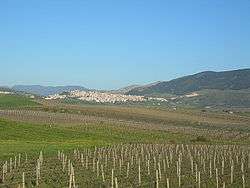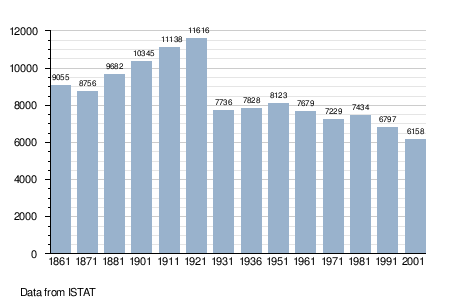Sambuca di Sicilia
| Sambuca di Sicilia Sambuca Zabut (until 1928) | |
|---|---|
| Comune | |
| Comune di Sambuca di Sicilia | |
 | |
 Sambuca di Sicilia Location of Sambuca di Sicilia in Italy | |
| Coordinates: 37°39′N 13°6′E / 37.650°N 13.100°ECoordinates: 37°39′N 13°6′E / 37.650°N 13.100°E | |
| Country | Italy |
| Region | Sicily |
| Province / Metropolitan city | Agrigento (AG) |
| Government | |
| • Mayor | Leo Ciaccio (Partito Democratico) |
| Area | |
| • Total | 95.88 km2 (37.02 sq mi) |
| Elevation | 364 m (1,194 ft) |
| Population (31 December 2010) | |
| • Total | 6,207 |
| • Density | 65/km2 (170/sq mi) |
| Demonym(s) | sambucesi |
| Time zone | CET (UTC+1) |
| • Summer (DST) | CEST (UTC+2) |
| Postal code | 92017 |
| Dialing code | 0925 |
| Patron saint | San Giorgio |
| Saint day | 23 April |
| Website | Official website |
Sambuca di Sicilia (Sicilian: Sammuca) is a comune (municipality) in the Province of Agrigento in the Italian region Sicily, located about 68 kilometres (42 mi) southwest of Palermo and about 89 kilometres (55 mi) northwest of Agrigento. As of 31 December 2010, it had a population of 6207 and an area of 95.88 square kilometres (37.02 sq mi).[1]
Sambuca di Sicilia borders the following municipalities: Bisacquino, Caltabellotta, Contessa Entellina, Giuliana, Menfi, Santa Margherita di Belice, Sciacca.
History
The origins of the name are uncertain. The main assumptions: Sambuca as a Greek musical instrument in the shape of a harp or the implantation of the old town. Sambuca from the elderberry plants, widespread in antiquity in the valley of Lake Orange. Leonardo Sciascia breaks down the current name Sambuca in as-Sabuqah and interprets it as a "remote place". Vincenzo Navarro decreed that "Sambuca", "Zabut" is nothing but an "Arpette" and until 1928 the town was called Sambuca Zabut. in 1928, Benito Mussolini removed Zabut and added "of Sicily".
Sambuca, was founded by the Arabs around 830, a few years after their landing in Sicily and was called Zabuth (in remembrance of the same name Zabut Al-Arab emir who had built a castle at that place) and built the slopes of Mount Genuardo, between the rivers Belice and Sosius, 350 meters above sea level Zabut Al-Maghrebi was a follower of the ascetic Ibn Mankud Conqueror 's "Burning Warrior of faith," Lord of the independent Kabyle of Trapani, Marsala, Sciacca. Zabut was inhabited by Muslim population until the thirteenth century until was conquered by Frederick II. From the fifteenth to the nineteenth century, Sambuca experienced vicissitudes of prosperity and plagues, prosperity and misery, splendor and earthquakes. Despite all Sambuca progressed. The court passed the Roman family Barberini and new neighborhoods were built, widened the city wall were built palaces and baronial mansions, churches, monasteries, convents. The Land of Sambuca was promoted from Barony to Marquess with the privilege of Philip II of Spain (Madrid 15 November 1570). The Marquess of Sambuca, the 16 September 1666, passed to Beccadelli family from Bologna risen to the rank of princes of the Principality of Camporeale. Sambuca in the nineteenth century is rich with culture. In those years it formed an enlightened middle class, which the animator Vincent Navarro was more qualified as a medical time out, writer, poet and patriot.
Geography
Sambuca di Sicilia is located at 37°39′2″N 13°6′42″E / 37.65056°N 13.11167°E. The city has a total area of 37 square miles (95.88 km²). The territory of Sambuca di Sicilia is located in the South-West of Sicily, 42.25 miles (68 km) far from Palermo, about 21 miles (34 km) far from the archaeological park of Selinunte, and about 13 miles (21 km) far from Menfi, that has beaches still pristine and the Blue Flag beach for its sea. Perched on a hill, the town of Sambuca di Sicilia is surrounded in the North-East from hills and woods, including the towering peak of Mount Genuardo (3305 feet - 1.180 m), in the South-West by the valleys of the river Carboj that form the reservoir of Lake Arancio. The beautiful woods surrounding the town are full of local legends and myths.
Tourism and culture
So many styles are intertwined and Sambuca has witnessed many times, and preserves the signs. On Adranon mountain there is the archaeological complex of the 4th century BC and the old Arab house in the holiday area of Adragna. 19th-century palaces and baroque facades blend with the old town of Arab descent whose most vivid expressions are: setti vaneddi (seven Saracen alleyways), the Mother church and the Belvedere terrace, the remains of the ancient castle of the Emir. Highlights include the 17th-century palace Panitteri (home of the ethno-anthropological museum), the palace of Arpa (town hall) and the palace Ciaccio, the Carmine church with the Antonello Gagini's marble statue of the Madonna dell'Udienza (Our Lady of the Audience) and the church of St. Michael Archangel with its wooden equestrian statue of St. George, patron Saint of Sambuca di Sicilia, slaying the dragon.
Sign of a population-conscious culture, is the Municipal Theatre "L'Idea" and the Institution Gianbecchina. Outside the center, are the ancient towers of Pandolfina and Cellaro, the Fortino di Mazzallakkar which emerge only in the summer months when the lake level is lowered.
Demographic evolution

Sister city
-
 Winter Haven, Florida, United States (1984), on the occasion of the Water Ski World Cup performed on the Lago Arancio, in Sambuca di Sicilia, Italy. Both cities are in fact involved to this sport.
Winter Haven, Florida, United States (1984), on the occasion of the Water Ski World Cup performed on the Lago Arancio, in Sambuca di Sicilia, Italy. Both cities are in fact involved to this sport.
References
External links
- Official site of Sambuca di Sicilia
- Pro loco "L'Araba Fenicia" - Tourism promotion organization
- Sambuca di Sicilia on MySpace